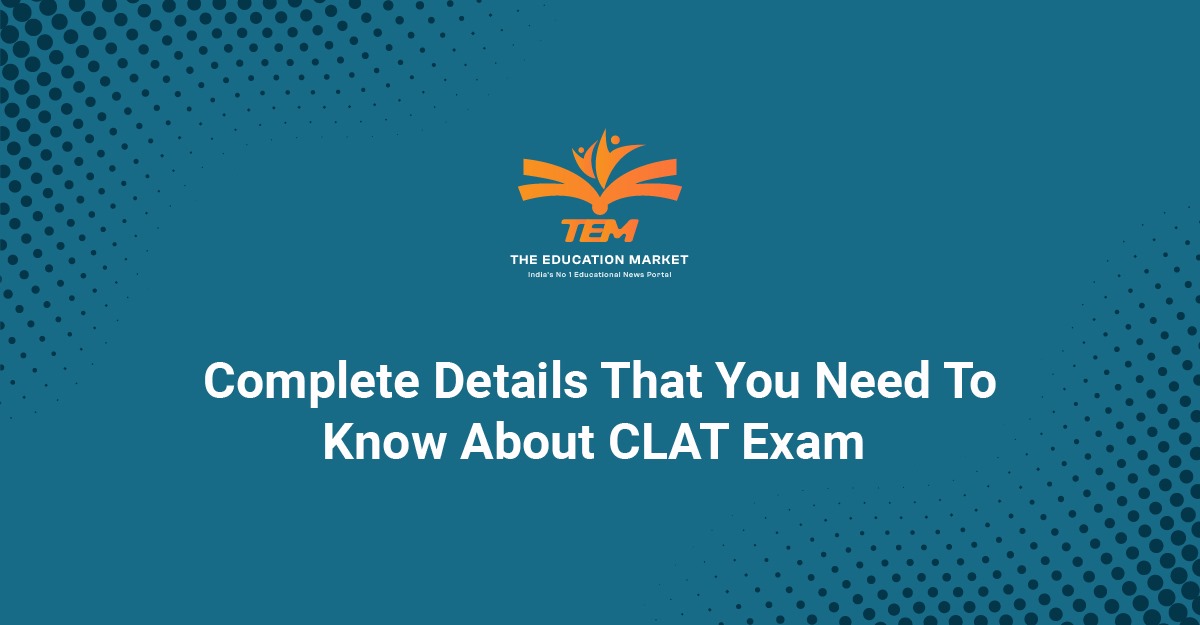CLAT (Common Law Admission Test) is one of the finest and most competitive exams in India that helps students gain admission to the best law schools. India has some top-ranked law universities where seats are limited, so to gain admission to the universities, students have to compete. CLAT is a competitive exam, students have to score high ranks to increase their chances of selection. The exam is a centralized national-level law entrance exam conducted by The Consortium of Law Universities (NLUs). The exam is conducted for UG and PG courses in the law field by 25 out of 27 national law universities in India. National Law University, Delhi, and Meghalaya conduct their law exam for admission to the course. For the rest of the NLUs, students have to take the CLAT exam.
- Annual Test Takers: 1,00,000+ on average.
- Language For Exam: English
- Indian and Foreigners: Both are eligible to take the exam.
CLAT Syllabus UG & PG
UG Syllabus
There are 5 sections in the CLAT exam, each section has a different syllabus. Here are the sections and their syllabus:
- English Language
- Current Affairs, including General Knowledge
- Legal Reasoning
- Logical Reasoning
- Quantitative Techniques
English Language
Here is the English language syllabus for students to learn and prepare:
- Correcting Incorrect Grammar Sentences
- Spotting Grammatical Errors
- Fill in the Blanks
- Synonyms & Antonyms
- Tenses
- Active & Passive Voice
Legal Reasoning
Here is the legal reasoning syllabus for students to learn and prepare
- Legal Maxims
- Indian Constitution
- Important Supreme Court Judgments
- Important Acts and Amendments of the Legislature
- Legal GK
- Current Affairs
Logical Reasoning
Here is the logical reasoning syllabus for students to learn and prepare:
- Arrangements
- Number Series
- Syllogisms
- Logical Sequences
- Blood Relations
- Arguments & Conclusions
- Assertions and Reasoning
- Statements and Assumptions
- Seating Arrangement/Puzzle Test
- Puzzles
- Clocks and calendars
- Circular Arrangements
- Analogies
- Direct sense
- Coding Decoding
- Connectives
Current Affairs, including General Knowledge
Here is the current affairs syllabus for students to learn and prepare:
- Current developments in India and throughout the world
- Arts and Culture
- International affairs
- Historic events of enduring importance
Quantitative Techniques
Here is the Quantitative aptitude syllabus for students to learn and prepare:
- Number theory and basic arithmetic
- Mixtures and allegations
- Time and work
- Probability
- Time, distance, and speed
- Fractions and equations
- Averages and Percentages
- Monetary evaluations
- Ratio and Proportion
- Permutation and combinations\
Also Read: Knowledge Nation Law Centre
PG Syllabus
In addition to the compulsory UG syllabus, the PG CLAT exam also has follow additional topics to cover:
- Criminal Law
- Property Law
- Public International Law
- Labor & Industrial Law
- Jurisprudence
- Administrative Law
- Law of Contract, Torts
- Company Law
- Constitutional Law
- Tax Law
- Environmental Law
- Family Law
CLAT Exam Pattern
Here is the CLAT exam pattern that students need to know:
| No of Questions | UG- 150 PG- 120 |
| Type of Questions | MCQs |
| Mode of Paper | Pen and Paper |
| Medium | English |
| Marking Scheme | +1 for correct answer -0.25 for incorrect answer |
| Duration | 2 Hours |
| Total Sections | UG– 5 sections PG- 5 sections + law subjects |
Also Read: 7 Best CLAT Coaching Institutes in Delhi (Rank wise)
CLAT Eligibility Criteria- UG & PG
To appear for the CLAT exam, students must be eligible to take up the courses in all ways. There are certain eligibility criteria that students need to check even before preparing for the exam. Here is the list of eligibility criteria for CLAT:
Age criteria: There is no set age limit to take the CLAT exam. However, to take up exams you must have a minimum age limit. Those taking up CLAT UG must be 16+ while those taking up CLAT PG must be a minimum of 20 years of age. So, students can check the age criteria to apply for the CLAT UG or PG exam.
Nationality: Indian Nationals, Non-Resident Indians (NRIs), Overseas Citizens of India (OCIs), and Persons of Indian Origin (PIOs) are eligible to apply for the CLAT exam to take admission to UG or PG law courses in India. However, they must apply in the NRI quota set by CLAT participating universities to be admitted.
Qualifications: Qualification is an important criterion to consider when it comes to the CLAT exam. Both UG and PG courses demand different qualifications for UG; you must have completed your 10+2 in any stream. However, to take CLAT PG you must have graduated in law or a relevant field.
Marks: Students applying for CLAT UG or PG must have minimum marks requirements fulfilled. For UG-General/OBC/PWD/NRI/PIO/OCI candidates must have a minimum of 45% marks and SC/ST candidates must have 40% marks in the 12th standard. For PG- General/OBC/PWD/NRI/PIO/OCI candidates must have a minimum of 50% marks and SC/ST candidates must have 45% marks in undergraduate degree.
Participating Universities In the CLAT Exam
Here is the list of national law universities participating in the CLAT exam. Students after clearing the CLAT exam can be admitted to these universities depending on their rank. Here is the complete list to check:
- National Law School of India University, Bangalore (NLSIU)
- Gujarat National Law University, Silvassa
- Dr. Ram Manohar Lohiya National Law University, Lucknow (RMLNLU)
- National Law Institute University, Bhopal (NLIU)
- The West Bengal National University of Juridical Sciences, Kolkata (WBNUJS)
- National Law University, Jodhpur (NLUJ)
- National law University Tripura, Agartala
- National Academy of Legal Study & Research University of Law, Hyderabad (NALSAR)
- Hidayatullah National Law University, Raipur (HNLU)
- Gujarat National Law University, Gandhinagar (GNLU)
- Rajiv Gandhi National University of Law, Patiala (RGNUL)
- Himachal Pradesh National Law University (HPNLU)
- Dharmashastra National Law University, Jabalpur (MPDNLU)
- Chanakya National Law University, Patna (CNLU)
- National University of Advanced Legal Studies, Kochi (NUALS)
- National Law University & Judicial Academy, Guwahati, Assam (NLUJAA)
- Damodaram Sanjivayya National Law University, Visakhapatnam (DSNLU)
- Tamil Nadu National Law School, Tiruchirappalli (TNNLS)
- Maharashtra National Law University, Mumbai (MNLU)
- Maharashtra National Law University, Nagpur (MNLU)
- National Law University, Cuttack, Odisha (NLUO)
- National University of Study & Research in Law, Ranchi (NUSRL)
- Maharashtra National Law University, Aurangabad (MNLU)
- Dr B.R. Ambedkar National Law University, Rai, Sonipat (DBRANLU)
Also Read: Best YouTube channels for CLAT preparation
Facts about the CLAT exam
There are some things that students must know about CLAT exam:
- There is no upper age limit to take CLAT UG or PG.
- There is no limit on the number of attempts that students can take for the CLAT exam.
- To gain admission, candidate names must be present in the CLAT allotment list.
- You must be able to submit results of previous qualifications at the time of admission.
- Students after B.Tech can take the CLAT exam if they fulfill the minimum marks criteria.
- Foreign nationals, NRI, and OCI can take the CLAT exam but must be able to fulfill special eligibility criteria.
Conclusion on Complete Details About CLAT Exam
These are complete details of the CLAT exam about UG and PG courses that students need to know. These details usually remain the same, there might be some changes for the coming exam. So, whenever students are preparing for the exam, they need to check complete details. However, most of the time these details remain similar. So, know this eligibility criterion and start preparing for the CLAT exam.
Related Article: Is coaching necessary to crack the DU.LLB. / CUET PG exam? , How to Prepare for the DU.LLB Exam? (Expert Tips and Tricks) , 7 Best DU.LLB Coaching Institutes in Delhi (Rank wise), 7 Best CLAT Coaching Institutes in India (Rank wise), How To Become a Judge? (Must Read).

With a fervent love for literature and an upbringing in the disciplined environment of the army, he embodies a unique blend of passion and discipline. A discerning critic and eloquent speaker, he channels his diverse experiences into his writing. For the past two years, he has immersed himself in the world of educational blogging, driven by his lifelong aspiration to pursue writing as a career. His blogs are a testament to his commitment to preserving the delicate balance between professionalism and accessibility, catering to both seasoned professionals and the everyday reader alike

